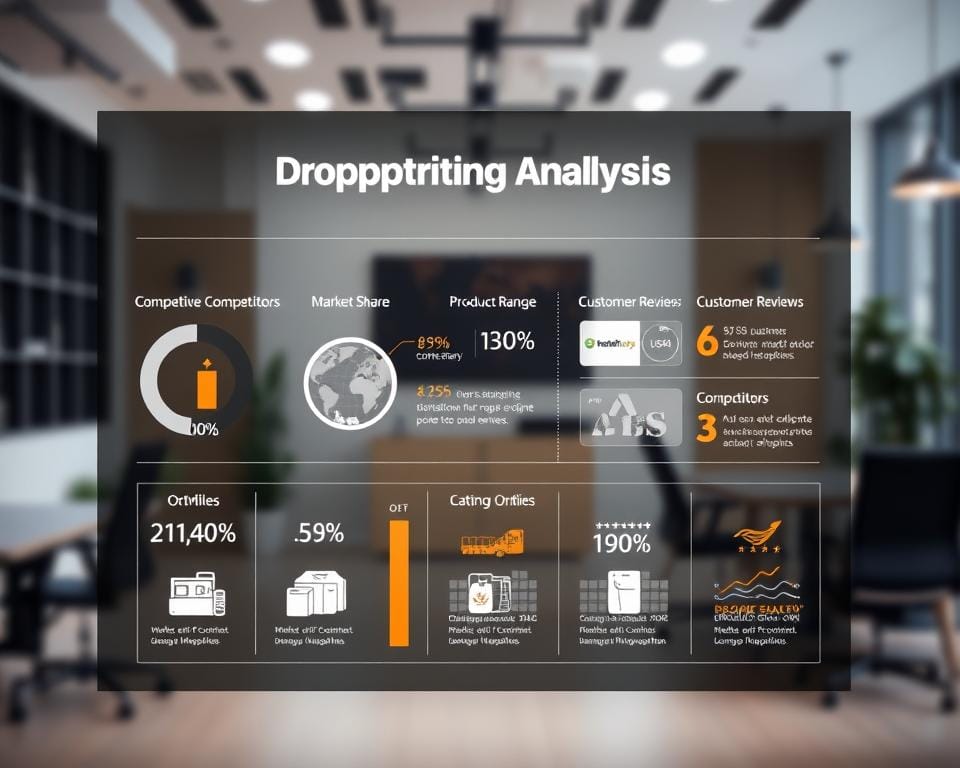Table of Contents
Product research is key for dropshipping success. It helps us pick the best products for our stores. This reduces risks and boosts sales. That’s why product research for dropshipping is a vital part of our strategy. With the dropshipping market expected to hit $128.6 billion in 20201, we need top-notch tools to stay ahead.
High demand products are crucial in dropshipping. They greatly influence what customers buy1. Tools like Google Trends help us see if a product is in demand, growing, or seasonal1. This makes dropshipping product research a must for our business.

Using data from product research tools helps us make better choices. This is key for getting the most out of our sales and marketing efforts1. With the market set to grow to $476.1 billion by 20261, we’re dedicated to leading the way with smart research strategies.
Understanding the Fundamentals of Product Research for Dropshipping
Finding the right dropshipping products is key. A good product research strategy can boost revenue by up to 30%2. It helps businesses find products that people want and avoid those that don’t sell well. In fact, 75% of dropshipping businesses say their success comes from good product research2.
By doing deep research, businesses can grow their revenue by 50% faster than those who don’t2.
To start with dropshipping niche research, you need to know what makes a product good for dropshipping. Look at market demand, competition, and profit margins. This helps find profitable niches and lowers the risk of failure. For instance, 60% of dropshipping products fail because of not researching demand enough2.
Some important metrics for dropshipping niche research are:
- Market demand: Is there a high demand for the product?
- Competition: How many other businesses are selling the same product?
- Profit margins: Can you sell the product at a price that allows for a decent profit margin?
By looking at these factors and doing thorough research, businesses can boost their chances of success. Over 80% of successful dropshipping entrepreneurs find trends through research tools2. Using these tools and doing good research helps businesses stay ahead and find the best products.
Essential Tools for Dropshipping Product Discovery
For dropshipping product sourcing, the right tools are crucial. We use different tools for dropshipping market research, spotting trends, and finding profitable items3. Tools like SaleSource, Dropship Spy, and Niche Scraper help us find trends, analyze competitors, and research products3.
These tools help us check if a product can make money. They look at selling prices and the costs of marketing and shipping3. They also give us insights into what’s popular and what people want, helping us make smart choices4. Tools like Sell The Trend use AI to find trending items that could do well in the market3.
Here are some key features of these tools:
- Trend detection and tracking
- Competitor analysis and product research
- Predictive analytics for demand forecasting
- Integration with e-commerce platforms like Shopify

Using these tools, we can make our dropshipping product sourcing easier. We can find products that make money and stay ahead of others3. It’s important to pick the right tools for our business, considering cost and what they offer4.
Analyzing Current Market Trends and Consumer Behavior
Identifying successful dropshipping products starts with understanding market trends and what customers want. We need to know what’s in demand to make smart choices. This means keeping an eye on dropshipping product trends and using tools like Google Trends to spot new trends5.
Social media sites like Instagram, TikTok, and Pinterest give us a peek into what people like and buy5. Tools like Sell The Trend and AliExpress Dropshipping Center also help by analyzing lots of data6.
Here are some key points to consider when analyzing current market trends and consumer behavior:
- Identify emerging trends and products that are currently in demand
- Use social media platforms to gather data on consumer preferences and popular products
- Leverage tools like Google Trends and Sell The Trend to identify profitable products
By following these tips and keeping up with market trends, we can find successful dropshipping products. This way, we stay ahead of the competition7.
| Tool | Description |
|---|---|
| Sell The Trend | Analyzes millions of data points to identify trending products and insights on competitors |
| AliExpress Dropshipping Center | Provides free access and deep analytics on product performance, including sales volume and customer ratings |
Competitive Analysis Strategies in Dropshipping
To succeed in dropshipping, it’s key to know how to find profitable products. Analyzing your competitors is a big part of this. By studying them, you can use their strengths and fix their weaknesses8. This means watching their prices, what they sell, and how they market to find gaps in the market.
Doing a good competitive analysis can boost sales by up to 30% if you watch your competitors closely8. Also, comparing yourself to 3-5 competitors helps spot market trends and sales strategies that work8. A SWOT analysis can help you see your own weaknesses, like bad customer service, which can lose up to 40% of customers if not fixed8.
Some important strategies for competitive analysis include:
- Watching competitors’ social media to get ideas that can boost customer engagement by up to 50%9
- Looking at competitors’ websites to make your own better and increase sales10
- Using tools like SimilarWeb and Ahrefs to learn about competitors and their traffic sources10

By using these strategies, dropshippers can get ahead and succeed in the market. Remember, finding profitable products is all about competitive analysis8.
Profitable Niche Selection Techniques
Choosing the right niche is crucial for success in dropshipping niche research. You must understand your audience and their needs. Meta’s Audience Insights can help by showing demographics, location, and interests11.
When picking a niche, look at its profitability. Check if there’s a high demand and low competition. For example, the car accessories market is growing fast, making it a good choice11.
Consider niches like car accessories, sustainability, and phone accessories. They have clear audiences, making marketing easier12. Use Google Keyword Planner and Google Trends to check keyword searches and trends11.

By using these techniques and tools, you can find great products for dropshipping. Always think about your audience and keep up with trends11.
Product Pricing and Profit Margin Optimization
Optimizing product pricing and profit margins is key in dropshipping. A good profit margin should be between 20% and 40%13. To find the profit margin, we use the formula: Net profit / Total revenue x 10014. For instance, if a product costs $61, a 30% profit margin adds $18.30, making the selling price $79.3014.
Market research is vital in finding the best pricing strategy. High-profit niches include jewelry, beauty, fitness, home decor, and electronics accessories. These items have low production costs but high value, allowing for big markups13. The average profit margin in dropshipping is between 15-60%15. To boost profits, consider the Cost of Goods Sold (COGS), Average Order Value (AOV), and Customer Lifetime Value (CLV)14.
Some products, like the Tire Inflation Pump, have a high profit margin of 49%. Sellers move over 5,000 units monthly, making around $254,653 in revenue13. Others, like the Portable Dual Screen Monitor for Laptops, have a 16.41% profit margin. Top sellers sell over 1,000 units monthly, making about $246,228 in revenue13. By understanding these metrics and optimizing pricing, dropshipping businesses can grow their profit margins and succeed in the long run.
Supplier Research and Verification Methods
When it comes to dropshipping product trends, finding good suppliers is key. We check if suppliers offer quality products, fair prices, and fast shipping16. A good supplier helps you sell successful dropshipping products, which is crucial for your brand.
We make sure products are good by checking them before they ship and listening to customer feedback17. This way, we catch any problems early and fix them.
It’s also important to have good relationships with suppliers. We talk to them often, negotiate prices, and pay on time18. This keeps our products coming and helps us stay competitive.
For more on finding products, check out product research. It’s full of tips on the latest dropshipping product trends and how to pick successful dropshipping products.

We use tools like Sell The Trend’s Nexus Product Research to see how products do17. This helps us pick the best products to sell, giving our customers the best.
When looking at suppliers, consider these things:
- Product quality and pricing
- Shipping times and reliability
- Customer service and support
- Return and refund policies
| Supplier | Product Quality | Pricing | Shipping Times |
|---|---|---|---|
| Tradelle | High | Competitive | 6-10 days |
| Jungle Scout | High | Varying | Varies |
| Sell The Trend | High | Competitive | Varies |
By following these tips and using the right tools, you can find reliable suppliers. This way, you can offer successful dropshipping products to your customers, keeping up with the latest dropshipping product trends16.
Testing and Validating Product Ideas
When looking for how to find profitable products for dropshipping, it’s key to test and validate ideas. This means checking if a product works well and if it fits the market. We can use different ways to test, like doing market analysis to see if there’s a big enough market and if people will pay for it19. Tools like Google Trends help us see if people are searching for the product, helping us avoid markets that are not growing19.
To make sure a product idea is good, we can try preorders. This shows if people really want the product, with more on the list meaning more interest20. We can also look at how people react to our social media posts to see if they like the product20. Watching what competitors do and how customers react can also tell us if the product will do well20. Some important things to think about when testing and validating ideas include:
- Knowing who your target audience is and what they need
- Looking at the competition and market trends
- Checking if the product works well and performs well
- Figuring out the price and if it will make money21
By taking these steps and using the right tools and strategies, we can better test and validate product ideas. This increases our chances of finding dropshipping products that will make money192021.
Common Product Research Pitfalls to Avoid
Dropshipping product research has its challenges. Many newbies think they can quickly make money, but it’s not that easy. They often give up after a few sales, showing how tough it is22. To do well, you need to know the basics and steer clear of common mistakes.
Understanding market trends and what customers want is crucial. Use social media and Google Trends to find what’s popular. This way, you can pick products that lots of people want23. But, most dropshippers fail because of mistakes in picking products and marketing23.
Watch out for products with low demand, too much competition, and low profit margins. Do your homework and check out your competition. Tools like Google Trends and Amazon Best Sellers can help you find trending items22. Also, picking a niche helps you target customers better and sell more22.
By avoiding these mistakes and choosing wisely, you can do well in dropshipping. Keep an eye on what customers want, study your competition, and update your products often. This way, you can succeed in the dropshipping world23.
- Do deep market research to find good niches and products
- Look at your competition to spot chances and avoid crowded markets
- Stick to one niche to better serve your customers
- Keep checking and changing your products to stay successful
By keeping these tips in mind and avoiding common mistakes, you can do well in dropshipping22.
Conclusion: Taking Action on Your Product Research
Thorough product research is key for a successful dropshipping business24. The dropshipping model is booming, thanks to online shopping. It’s crucial to find profitable products to avoid waste24.
By using the right tools and techniques, we can quickly find trending items. This helps us meet market demand24.
Understanding Google Trends and online communities helps us find profitable niches24. This knowledge is vital for a thriving dropshipping business25. Good product research leads to more sales and happy customers, making your business successful24.
It’s time to put what you’ve learned into action. Start looking for the best products for your store25. With a solid research plan, you can build a profitable dropshipping business. Let’s begin!
FAQ
What makes a product suitable for dropshipping?
We look for products with high demand and low shipping costs. We also consider the competition and profit margins. The product’s weight, size, and profit margins are key.
How do I evaluate market demand for a product?
To check market demand, we analyze search volume and sales data. We use tools like Google Trends and Amazon bestseller lists. Social media analysis also helps us understand interest in a product.
What are the key metrics to consider before starting a dropshipping business?
Important metrics include average order value and profit margins. We also look at product competition and customer acquisition costs. The business’s long-term sustainability and scalability are crucial.
What are the essential tools for dropshipping product discovery?
Tools like AliExpress, Oberlo, Jungle Scout, and Google Trends help find profitable products. We’ll show how to use these tools to find great products.
How can I use social media and Google Trends to identify profitable trends?
Social media platforms like Instagram and TikTok reveal emerging trends. Google Trends data helps us spot seasonal patterns and product interest.
How do I conduct effective competitive analysis in dropshipping?
We research competitors’ products, pricing, and marketing. This helps us find market gaps and stand out from the competition.
What are the key factors to consider when selecting a profitable niche?
We look for underserved markets and evaluate profitability. We assess the niche’s long-term potential, considering demand, competition, and entry barriers.
How can I optimize product pricing and profit margins?
We research market prices and understand customer willingness to pay. Finding cost-effective sources is key. We’ll discuss balancing competitive pricing and profit margins.
How do I evaluate supplier reliability and implement quality control measures?
We assess product quality, shipping times, and customer service. Quality control measures like sample testing ensure a positive customer experience and mitigate risks.
How can I effectively test and validate product ideas?
We use pre-sales, social media ads, and customer feedback to test ideas. This helps us identify promising products before starting a dropshipping business.
What are the common product research pitfalls to avoid?
Avoiding low-demand products and overlooking red flags is crucial. Learning from mistakes and managing risks are also important. We’ll discuss these pitfalls and offer tips for success.










